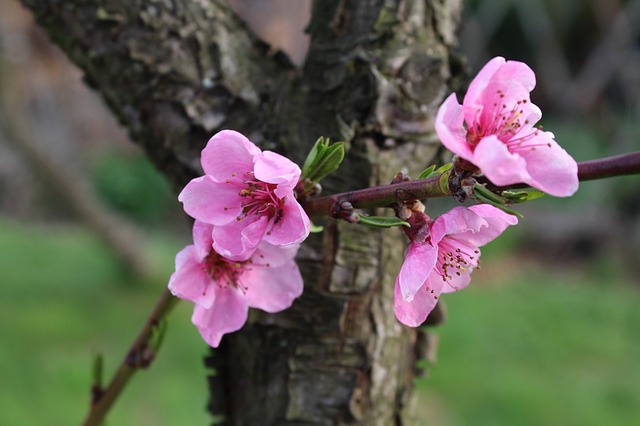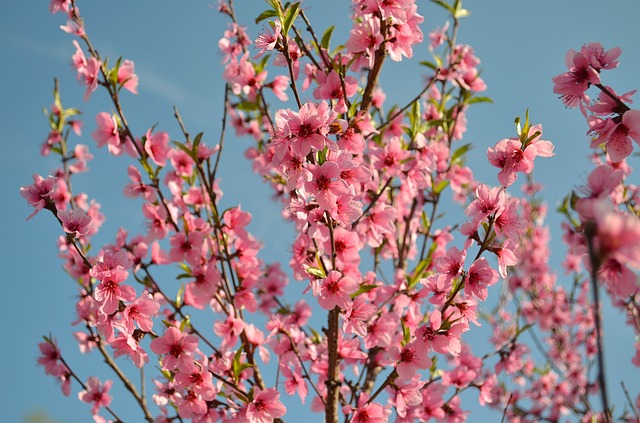Corrective Pruning Fruit Trees

Gardening Question from Michael:
My peach trees are about 7 yrs old and I have never trimmed them because I do not know how. I live in Illinois . About 4 yrs ago I had a good yeild of peaches and i canned them. Every year after when I get peaches, they seem to be drying up and just hang on the tree. I was told to cut the branches off, to thin the tree out. Also the trees are ozing sap out trunk and joints. Any suggestions on what I should do to help the trees.

Answer from Pat:
Yes, I sure do have a suggestion. You need to undertake a program of corrective pruning in winter or very early spring after your tree has dropped its leaves and before new buds open, followed by annual fall pruning to keep the tree growing and bearing. You also need to undertake a regular schedule of cleaning up the tree to remove all mummified fruit, debris, twigs, and dead fallen bark, and thoroughly clean up the ground under the tree in winter, followed by spraying with fungicide more than once in winter to control the pests and diseases that can and will beset neglected peach trees. Also cover the ground with fresh mulch under the tree after spraying and pruning. This will do much to control diseases, and fertilize your trees according the the time and directions provided by your local University Extension. Placing a layer of aged manure under the tree after cleaning the ground in fall, and covering the root zone but not touching the trunk, could do much to aid the health and recovery of your tree and would provide both fertilizer and mulch. (Deciduous fruit trees do not have a heavy requirement for fertilizer but they do need some.)
It sounds to me as if your tree is suffering from a disease such as brown rot, which results in mummified and rotting fruit, or it may have other fungus diseases such as bacterial leaf spot, which can also turn fruit brown and shriveled. Also, your failure to prune is why the tree can no longer bear much fruit. Oozing of sap can be caused by diseases such as gumosis, but also from peach-tree borers and other pests. Unfortunately, neglected peach trees always go into severe decline and seldom if ever come to a good end.
Peach trees need more severe winter pruning than any other deciduous fruit trees because the fruit is only born on one-year old shoots. Dormant spray is done to control pests as well as diseases. If you do not prune and if your tree isn’t bearing or only bearing on the tips, this is because you haven’t pruned it enough to stimulate growth of adequate new wood that will bear the following year.
Go to your local book store or look online and purchase a good book on pruning deciduous fruit trees. Make sure it contains diagrams. You will also need to know when to prune in your area. Here in California where I live we have a mild-winter climate so we prune our deciduous fruit trees in January. In summer the only pruning we do is to remove suckers arising from branches or from the ground. In Ohio the right time of year to prune a young peach tree is March. But your tree is a mature tree, and timing for that might be different, so refer to the University Extension In your area and phone the Master Gardeners for advice. I would expect March to be the time to prune, but I am not sure about the correct time to prune in Illinois, so ask the experts at your University of Illinois University Extension. Also send for a copy of Ohio State University Extension Bulletin 528. “Training and Pruning Fruit Trees.” (Mentioned below.) You can also find out if there is a similar publication in Illinois.
For your own safety I recommend you purchase a sturdy three-legged ladder. A three-legged orchard ladder is one of the best purchases a gardener can ever make. I have owned one of these for many years. With good care it can last a lifetime.
Brown rot is a fungus disease that attacks fruits and twigs of stone fruits. Peach leaf curl attacks the leaves of peach trees twisting them out of shape and can kill trees. Another disease is bacterial leaf spot which causes black or brown spots on green leaves and brown sunken areas on fruit. In order to prevent these diseases from ruining your harvest and killing your tree, in addition to pruning you will need to undertake undertake a regular program of annual dormant spray in late fall and winter, which you will need to repeat more than once. (Ask your University Extension when spraying should be done and wear protective clothing.) Spray with a product such as dormant disease lime sulfur spray mixed with horticultural oil against pests. Some organic gardeners claim that beneficial fungi control all negative fungi in their gardens, but obviously this is not the case in your garden. Thus you need to spray with dormant spray. If you are an organic gardener, choose an organic product, such as Bonide Organic Lime Sulfur Spray. Even organic gardeners need to use dormant spray on roses or if they intend to have any luck growing deciduous fruit trees, especially peaches that are more subject to disease problems than any other fruit tree.
For more information: Please refer to the information on peach leaf curl on pages 59 and 62 of my organic book and see the information on pruning of peaches and other deciduous fruit trees discussed on page 51. Page 382 once again covers the subject of peach leaf curl at the right time of year when we need to control it here. This timing of course will not be right for you, but will help others reading this blog.
For how to correct your tree’s shape and size, see UC University Extension Publication 8058: Pruning Overgrown Deciduous Fruit Trees. (This pamphlet is on the internet and includes excellent instructions for correcting an overgrown deciduous fruit tree.) Also see: Ohio State University Extension Bulletin 528. “Training and Pruning Fruit Trees.”
Ohio University Extension Fact Sheet 4321-1086 will also give you much information on growing peaches and nectarines in the home landscape.
University of Illinois Extension has some helpful information also:http://urbanext.illinois.edu/fruit/tree.cfm?section=tree
Also see this valuable information from the University of Illinois (Your state!) http://urbanext.illinois.edu/fruit/peaches.cfm?section=tree
It is not too late to save your peach trees but I hope you realize now you can’t simply plant them and forget them.


This is very informative article. It’s good to know programs of corrective pruning. Pat’s answer was so interesting to read.
I live in New Hampshire and am learning how to care for my young fruit trees all planted within the last 2.5 to 3 years. My peach tree was traumatized last year. Too much fruit, my fault (learning) it almost tipped over and I heard a crack from the lower trunk area last year. I checked for damage and saw some sap bleeding from the soil level area of the trunk. This year around two-thirds of the tree has no growth. The other third has lots of leaves and growth but no flowering. There is a lot of sap bleeding from the branch that was bending down the most with fruit last year and it’s one of the bare branches this year. I think severe pruning may be needed to sort of restart the tree. I accept it needs time to heal if it can still heal. The trunk is only 3.5 inches around, it looks pretty skinny to me. Again it’s a young tree from a nursery and looked fine with lots of fruit when I bought it. It’s just under 6 feet high and maybe around 36 inches in diameter.
It sounds as if you neglected early training of your peach tree. It also sounds as if this tree, like many others, was affected by global warming and climate change and grew more rapidly than deciduous fruit trees usually do. I am guessing it put on far too much foliage and fruit too soon in its young life. Correct pruning from the get-go would have strengthened the trunk and branches, but this early training was totally neglected. It also sounds as if you never thinned out the fruit. This error can break branches and also render fruit that is too small.
I suggest you purchase a reputable pruning book and go back to step one. You could also look online and see if your state Agricultural Extension offers a pruning guide for your climate zone. Armed with this correct information next autumn, remove all dead wood and straighten out the pruning this winter while the tree is dormant. Unfortunately the cracking you describe may have allowed pests such as borers and possibly also diseases to invade the inner wood of the tree. Perhaps later on this will lead to rot.
Nonetheless, see if you can do corrective pruning after leaves fall. Be sure to follow wise printed directions and charts to bring about a stronger tree and strong trunk and branch structure. Otherwise, your wisest choice is to cut down this tree and begin again with a new tree and next time do the job right.